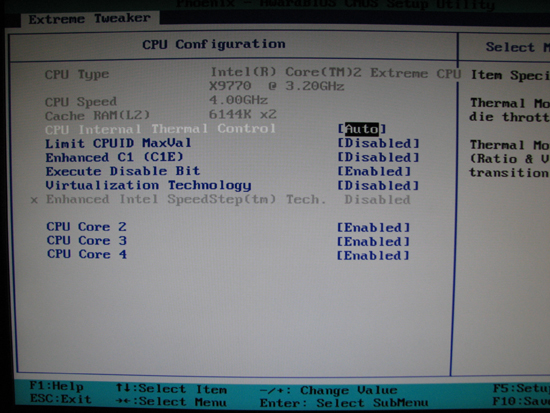ASUS Striker II Extreme: Mucho Bang, Mucho Bucks
by Kris Boughton on April 11, 2008 7:00 AM EST- Posted in
- Motherboards
Complete BIOS Tuning Guide - "CPU Configuration"

CPU Configuration
CPU Internal Thermal Control - [Auto, Disabled] Always leave this on Auto as disabling internal thermal control can have unknown affects on system operation. According to sources at Intel, thermal control is required to be active if the CPU is expected to correctly function within specifications.
Limit CPUID MaxVal - [Enabled, Disabled] Some legacy operating systems (i.e. Windows NT SP2 and older) are unable to properly deal with the CPUID x86 opcode when called using operands greater than 3. The problem is that the boot code for these older system was written to query the CPU for the highest supported value and then to call a routine using this value. Unfortunately, the programmers did not have the foresight to account for future processors with higher values and the OS crashes with a BSOD due to the unhandled exception in a routine running with kernel mode privileges.
The result is a general incompatibility between these newer CPUs (with a maximum supported CPUID value of 4) and these older operating systems. Set this to Enabled if you experience just such a problem, otherwise leave this Disabled. Beware that improperly enabling this setting with Windows 2000, XP, or any flavor of Vista can cause serious performance problems.
Enhanced C1 (C1E) - [Enabled, Disabled] C1E functions to reduce the CPU multiplier to 6.0x when idling or running in load-load conditions. This can sometimes provide a small degree of power savings, especially if the system is highly overclocked to begin with. Most users find the constant switching between the idle and load frequencies annoying, besides which a small performance penalty is experienced during each transition. We usually disable this setting and recommend you do the same if you are building your system for gaming purposes.
Execute Disable Bit - [Enabled, Disabled] The Execute Disable (NX) Bit is typically used as a form of hardware protection against the execution of malicious code. This bit is part of the page table descriptor used to mark the memory page table as executable or not. This way programs that purposefully cause buffer overflows that end up spilling into the memory address space of other processes cannot execute injected data unless the page is specifically marked as containing executable code. Enabling this feature will force Physical Address Extension (PAE) Mode when running a 32-bit Windows OS regardless of the amount of system memory installed. This is because the NX bit resides at bit 63 of the page table entry and page table entries are only 32 bits in length with PAE disabled. 64-bit operating systems always run in PAE Mode. Enabling this feature has never negatively affected our ability to overclock.
Virtualization Technology - [Enabled, Disabled] This setting controls whether or not the BIOS masks requests sent to the CPU in determining whether or not Virtualization Technology (VT) is supported. Disabling this setting ensures the system cannot run any code pertaining to system virtualization. We usually leave this Disabled unless we have a good reason to enable it.
Enhanced Intel SpeedStep(tm) Tech. - [Enabled, Disabled] Although some BIOS releases may allows this features to be alternately Disabled or Enabled, it has no affect unless the installed CPU is capable of conducting power state transitions and no desktop chipset contains this feature set (yet). This option should be grayed out unless you have some special CPU have not encountered.
CPU Core 2/3/4 - [Enabled, Disabled] This setting merely controls a mask used by the BIOS in determining which cores are advertised as available for use by the host systems. Disabling cores can sometimes allow a quad-core CPU to function more like a dual-core CPU when it comes to FSB clocking. Numbering the cores from 1 is a mistake in our opinion; this option should really read "CPU Core 1/2/3".










23 Comments
View All Comments
seamusmc - Friday, April 11, 2008 - link
For folks considering this board, I strongly recommend visiting xstremesystems.org's forums.Several people are experiencing data/OS corruption when performing any FSB overclocking. (Brings back memories of the early days of the 680i.)
nomagic - Friday, April 11, 2008 - link
LGA775 Core2 Duo/Extreme/Quad, Pentium EE, Pentium D, Pentium including next-generation 45nm CPU supportWhich would include Nehalem, I suppose? Should I also assume that a BIOS update would be required for Nahalem support? Is it possible that a custom board like this might have trouble supporting Nehalem when the times comes?
TemjinGold - Friday, April 11, 2008 - link
No. NOTHING out right now can support Nehalem as that's a completely different socket (different pin count too).